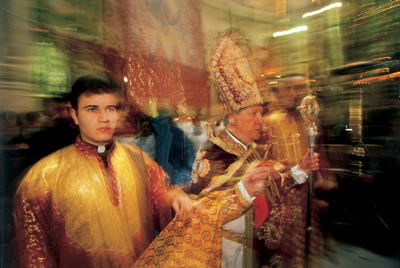|
HISTORIC SITES
The Evangelical Triangle
Though Christianity developed along the
shores of the Sea of Galilee, this area has not attracted nearly as many
Christian pilgrims as one would expect for a variety of reasons. This
may change soon thanks to the plans to create a Christian heritage park
that will help the public understand what was happening in the Galilee
in the first century.
by Yadin Roman
The new Christian
center, sponsored by evangelical communities from around the world,
which is planned for the outskirts of Capernaum, has refocused attention
on the Sea of Galilee – especially on the happenings on its shores
during the stormy days of the first century. At that time, the Galilee
was the center of the agitation that led to the rebellion of the Jews
against the Romans, to the destruction of the Temple, and, as an
aftermath, to the reformation of Judaism as we know it today. The
messianic yearnings behind those events also made the Galilee the
spawning grounds of Christianity. Three-quarters of the events described
in the New Testament happened in the Galilee, particularly in the area
around the Sea of Galilee.
A better
understanding of the heritage of the Sea of Galilee is the key to
understanding many of the events that formed western civilization as we
know it today. The differences between the two cultures inhabiting
opposite sides of the lake – Jewish farmers and fishermen on the
northwestern side and sophisticated Hellenist cosmopolitans on the
southeastern side – explain the antagonism between Judaism and
Hellenism, on the one hand. The proximity and the shared natural
settings show why the parables and the teachings of Jesus appealed to
both citizens of the Roman cities and Jews.

The Sea of Galilee and its
surroundings, where Jesus preached, should be meaningful to religious
Christians. (Doron Horowitz)
The cultural
landscape of the Sea of Galilee is one of the reasons that Christianity
caught on so quickly in the urban centers of the Roman Empire. This area
is where the concepts of hanging on through the hard times of the Roman
Empire and of creating the kingdom of heaven by rebellion were born. The
Golan Heights, to the east of the lake, was the base for the rebels who
would start the rebellion. They were extreme, messianic, and believed in
fighting to the end – against all odds. The seeds of the rebellion,
which ended with a mass suicide at Masada following the destruction of
the Temple, were sown at Arbel and Gamla. But just below the Golan
Heights, around the Sea of Galilee, in the towns of the gentle fishing
folk, a different message thrived: “Stay put;” “Stick out the hard
times;” and “Do not rebel.” In his sermons, Jesus blessed the
peacemakers – those who did not rebel or possess the desire to bring the
kingdom of heaven into being by the sword of man. As they sat on a hill
overlooking the Sea of Galilee and the Golan, Jesus’ listeners knew
exactly to whom he was referring.
There are hundreds
of sites around the Sea of Galilee connected to the stormy days of the
first century. They range from natural sites, which illuminate many of
the parables in the New Testament, to the towns, villages, synagogues,
trees, beaches, hills, and cities that can play an important part in
helping visitors understand both Jewish history and the New Testament.
Despite this,
tourists, and especially Christian pilgrims, have spent very little time
exploring the Sea of Galilee area. Most pilgrims take a quick half-day
tour that crams in a visit to the Church of the Beatitudes, the Church
of the Multiplication of the Loaves and Fishes, and Capernaum. They
devote three or four hours, at the most, to exploring the most
significant area in Israel relating to Christian heritage.
The reason for this
lies in the way tourism, and especially pilgrimage, developed in the
Land of Israel. Until 1967, Jordan promoted itself as the Holy Land. The
biblical sites of Judea and Samara, Jerusalem, Bethlehem, and Hebron
were all in Jordan. Most pilgrims visited Jordan. Only a few were ready
to face the obstacles involved in crossing from Jordan to Israel via the
Mandelbaum Gate in Jerusalem.
In 1964, Pope Paul
VI visited Jordan and Israel. In order to avoid going through the
official crossing point between Jordan and Israel – two countries whose
authority over Jerusalem was not recognized by the Holy See – a special
road was constructed that led down Mount Zion and connected the
Jordanian-held Old City with Israeli Jerusalem in the west. During his
visit, the pope consecrated the new Church of the Annunciation in
Nazareth and visited the three Christian sites on the Sea of Galilee,
all held by Catholic orders. His visit did encourage a few more Catholic
groups to visit Israel, but, all in all, these were few and far between.

Mass at a church in Nazareth. (Doron
Horowitz)
The Six Day War was
the turning point in tourism to Israel. Following the war, all the sites
of the Holy Land were under Israeli control, from the site believed to
be Mount Sinai to the monastery of Saint Catharine. But this was not the
only factor in the dramatic change in tourism that was about to happen.
The full
article
appeared in ERETZ Magazine 103. To read it, subscribe to ERETZ Magazine.
|

